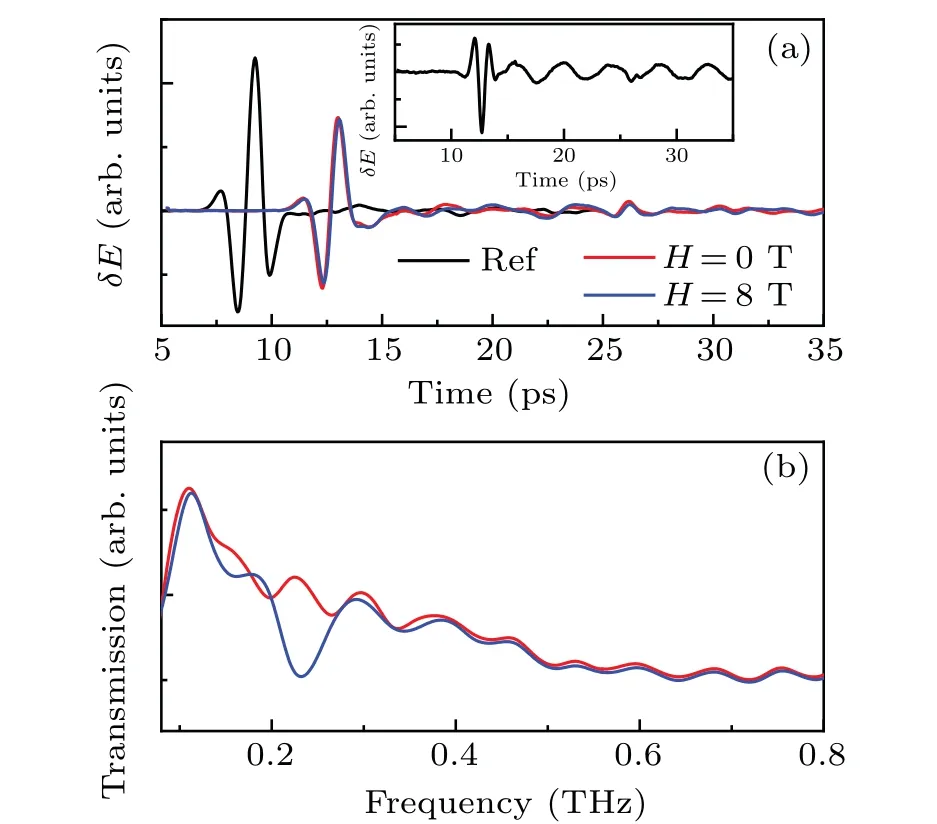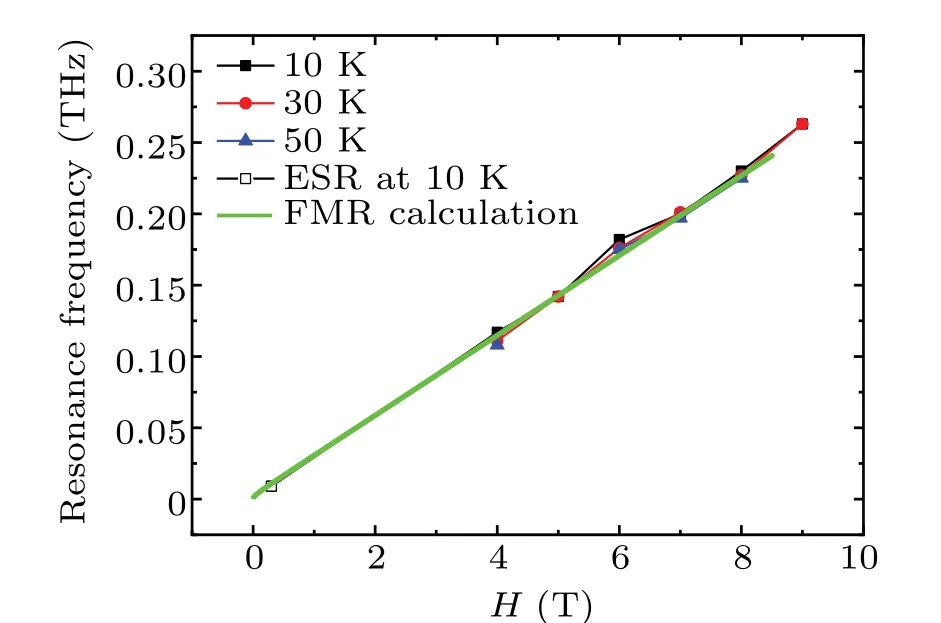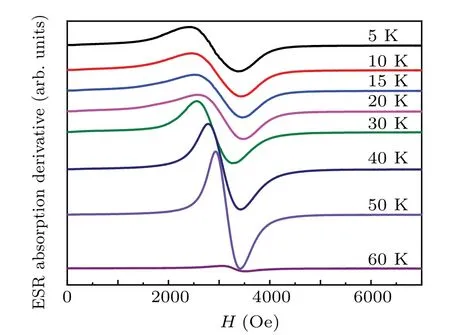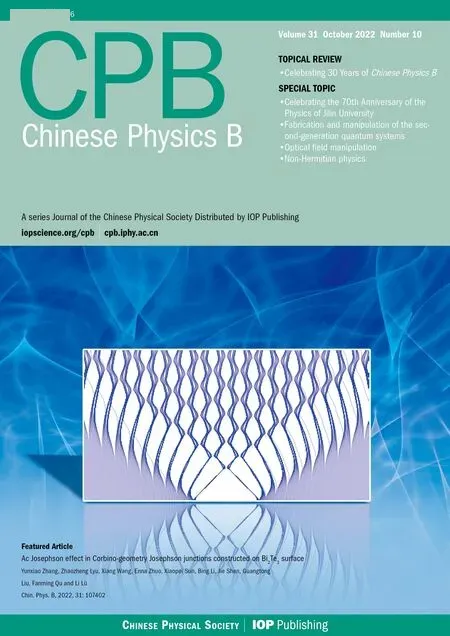Terahertz magnetic resonance in MnCr2O4 under high magnetic field
Peng Zhang(张朋) Kaibo He(贺凯博) Zheng Wang(王铮)
Shile Zhang(张仕乐)2, Jianming Dai(戴建明)3, and Fuhai Su(苏付海)3,‡
1Department of Physics,Laboratory of Functional Materials and Device for Informatics,Fuyang Normal University,Fuyang 236037,China
2Anhui Provincial Key Laboratory of Condensed Matter Physics at Extreme Conditions,High Magnetic Field Laboratory,Hefei Institute of Physical Science(HFIPS),Chinese Academy of Sciences,Hefei 230031,China
3Key Laboratory of Materials Physics,Institute of Solid State Physics,HFIPS,Chinese Academy of Sciences,Hefei 230031,China
Keywords: chromium spinel,terahertz time-domain spectroscopy,ferromagnetic resonance
1. Introduction
Compounds with the spinel structure exhibit a wide range of interesting electronic, optical, and magnetic properties.Among them, chromite spinel compounds with the general formulas expressed as ACr2O4possess a variety of physical effects(such as magnetic frustration,magnetoelectric coupling,multiple magnetic ordering,etc.),[1–6]which attracted the attention of researchers and engineers. Geometrical frustration in ACr2O4oxides results in noncollinear spiral magnetic ordering as well as in concomitant magnetoelectric coupling and strong magnetic frustration. Strong magnetic frustration also occurs in the pyrochlore sublattice B in the case Cr3+are antiferromagnetically coupled,and if the exchange interactions in B–B networks are the same or stronger than those in the A–B networks.[7–9]Such a frustration also yields low-temperature spiral magnetic ordering.
In this regard, MnCr2O4spinel oxides has attracted special attention from scientists. MnCr2O4is a cubic ferrimagnetic compound withTcof 41 K. Its spiral component is orthogonal to the ferrimagnetic order direction below 20 K.[10]The magnetically active Cr3+and Mn2+occupy the octahedral and tetrahedral B and A sites,respectively. The exchange interactions of Mn2+and Cr3+with unfilled 3d3orbitals can result in a complex noncollinear magnetic order consisting of long-range ferrimagnetic and short-range spiral spin order components at low temperatures. Therefore,understanding of the competition betweenJMn-CrandJCr-Crexchange interactions as well as corresponding spin dynamics in MnCr2O4is essential. In addition, the presence of magnetic moment on A-and B-sites can change the magnetic and structural properties of the whole oxide,resulting in the spin frustration.[11,12]In general, the frustration may lead to the intricate ground states and likely impact the magnetic excitations.For instance,the frustration plays a key role for the quantum critical magnetic excitations of spin chains in CoNb2O6,[13]and tends to the suppression of terahertz (THz) magnetic resonance in Cu5-xZnxV2O10(CsCl).[14]So far, as one of typical frustration systems, MnCr2O4remains elusive in the spin dynamics in THz range.
Terahertz spectroscopy is a powerful tool to analyze the THz spin dynamics of ACr2B4compounds in the far-infrared region and helped to merge microwave and optical spintronics technologies.[15–19]The coherent generation and detection of broadband THz electromagnetic pulses using timedomain spectroscopy (TDS) allowed research of the complex index dispersions in a broad spectral range without using the Kramers–Kronig transformation.[20–22]In recent years,the THz-TDS techniques are extensively employed to study the THz magnetic resonances including quasi-ferromagnetic(FM)and quasi-antiferromagnetic(AFM)mode in rare earth orthoferrites RFeO3,[23,24]and probe the electromagnon mode,[25]as well as determine the magnetoelastic coupling constants in multiferroic BiFeO3.[26]In this work, we perform theTHz-TDS for a single MnCr2O4crystal at low temperatures and magnetic fields up to 9 T using THz-TDS. We find that the magnetic resonance driven by a high magnetic field fall in the THz frequency range, which agreed well with the ferromagnetic resonance behavior. This work provides fundamental data needed for a deeper understanding of the low-temperature spin dynamics mechanism of spinel chromium oxides.
2. Samples and experiments
Polycrystalline MnCr2O4was synthesized by the solidstate reaction using corresponding stoichiometric ratios of commercially acquired MnCO3(purity 99.999%) and Cr2O3(purity 99.995%) powders. The mixtures were calcined in Al2O3crucibles in for 16 hours at 1100°C in the air. The resultant samples were ground, pressed into pellets, sintered first at 1200°C for 24 h,and then at 1300°C for 24 h with an intermediate grinding.
The phase composition and crystal structure of the ground samples were analyzed by x-ray diffraction (XRD), which confirmed the purity of the samples and their cubic spinel structure. THz transmission spectroscopy was performed at low temperatures under an external magnetic field up to 9 T using pellets(5 mm in diameter and 1-mm thick).For this purpose,a custom-built THz magneto-optical time-domain spectroscopy (MO-TDS) system was used.[27–30]A mode-locked Ti:sapphire femtosecond laser delivered 150-fs pulses with 800-nm center wavelength and 76-MHz repetition rate. The pulses were divided into pump and probe beams. The pumping laser pulses were focused onto an LT-GaAs photoconductive antenna capable of generating the pulses in the range of 0.1 THz–1.5 THz. A free-space electro-optic sampling of single-crystalline ZnTe was used for the detection of the p-polarized electric field amplitude of the THz waveforms in the time domain. A superconducting Oxford Spectromag SM4000 magnet was applied to exert the magnetic field and tune the sample temperature. The THz spot was 1.5 mm in diameter at the focus position, at which the sample was attached to a Cu cold finger with a 3-mm hole. During the transmission measurements, we used the Faraday geometry.Namely, the magnetic field direction was parallel or antiparallel to the THz beam propagation direction. The incident THz pulse possessed a p-polarized electric field. We adopted a zero-field cooling for the temperature variation. THz spectra were recorded under a constant flow of dry nitrogen gas. The magnetic measurements were conducted in the range of 5 K–300 K using a SQUID superconducting quantum interference device quantum design. Continuous-wave X-band electron spin resonance(ESR)spectra were collected in a transmission mode using Bruker EMXPlus 10/12 instrument coupled with an Oxford Cryogenics cryostat at 4 K–300 K, 9.39-GHz microwave frequency, and the applied magnetic field sweep up to 14.5 kOe(1 Oe=79.5775 A·m-1).
3. Results and discussion
The magnetization results we recorded at different temperatures as a function of the applied magnetic field (shown in Fig.1)agreed with the literature.[27]After the initial sharp increase, magnetization at 10 K and 30 K increased linearly with the magnetic field with almost the same slopes.However,a nonlinear trend was observed at 50 K(shown in the inset of Fig. 1). A sharp increase at~40 K corresponded to the ferrimagnetic transition(Tc),which was so well defined because of the intense magnetization increase of the MnCr2O4sample at this temperature. The anomalies observed at 18 K and 14 K indicate the formation of a helicoidal order and development of the spiral structure.[31,32]Thus, magnetization test results suggested that the short-range spiral magnetic order strongly depended on the applied magnetic field.

Fig.1. Magnetization at 10 K,30 K,and 50 K as a function of the magnetic field(in unit kOe). The inset shows DC magnetization in zero-field-cooled(ZFC)and field-cooled(FC)sequences at H=100 Oe.
THz pulses transmitted through the samples were recorded using a THz waveform passing through an empty sample holder as a reference. During the tests conducted under the external magnetic field, both the wave vector (k) and magnetic field component (h) of the THz beam were positioned vertically with regards to the static magnetic field(H),which allowed the magnetic field component of each THz pulse to drive the magnetic moment and induce the magneton excitation. A comparison of the transmitted THz electric fields recorded with and without the external magnetic field(shown in the inset of Fig. 2(a)) showed oscillations 4.5 ps apart. These oscillations indicate the occurrence of resonance induced by the magnetic field. To reveal the details in the frequency domain,the THz transmission spectra(expressed as

according to Fresnel laws without the Kramers–Kronig transformation)were collected at 10 K under an external magnetic field (see Fig. 2(b)). ˜Et(ω) and ˜Eref(ω) correspond to the complex FFT spectrum transmitted through the sample and an empty sample holder, respectively. A dip at~0.23 THz was observed in the transmission spectrum recorded at 8 T,which is consistent with the oscillation period observed in the time domain. However, no evident absorption was identified at 0 T. These results indicated the occurrence of a magneticfield-induced resonance in the THz frequency region.

Fig. 2. (a) THz pulses transmitted through the MnCr2O4 sample and (b)THz amplitude transmission spectra at 0-T and 8-T magnetic fields. The inset of Fig.2(a) shows ΔE(t)=EH(t)-E0(t)values. The measurements were carried out at 10 K.


Fig.3. THz amplitude transmission spectra recorded at 1 T–9 T at(a)1 K,(b)30 K,and(c)50 K,respectively. The dotted lines are drawn for the presentation purposes only.
The high magnetic field resonance is consistent with a linearω–Hfunction at all temperatures tested in this work (see Fig.4)and is equal to 0 THz atH=0 T.The linear behavior of the magnetic field can be described by the Larmor procession energy: ¯hω=gμBH,plotted as green dotted lines in Fig.4. In this formula,μBis Bohr magneton andgis the paramagnetic region factor. Linearω–Hrelation indicates the prevalence of the ferromagnetic resonance from Cr3+spin in the high field range. The magnetic field dependence on resonance energy was almost identical for 10 K and 30 K.However,the slope of the curve obtained for 50 K is smaller,which implies thatTcis above 50 K.The extractedg-factor was equal to~2.0 for 10 K and 30 K,and to~1.957 at 50 K.Such magnetic field dependences are consistent with the magnetization curves shown in Fig. 1. However, magnetization at 50 K was smaller than at 10 K and 30 K at high magnetic field values.

Fig. 4. The magnetic resonance frequencies at 10 K, 30 K, and 50 K as a function of the applied magnetic field.

Fig.5. ESR spectra of MnCr2O4 at different temperatures.
The ESR analysis of how MnCr2O4performed at different temperatures showed that the resonance the paramagnetic range consisted of a single structureless Lorentzian line centered atHr=3370 Oe (see Fig. 5),Hris the resonance field,the resonance field is extracted from the fit. As the temperature decreased,Hrshifted to lower magnetic fields, and ΔHbroadened. The resonance center fieldHrat 30 K was equal to 0.285 T.By substituting theg-factor equal to 2 into the formulag=(ωh)/(μBHr),we obtained the resonance frequency value equal to 9.41 GHz. The ESR frequency is consistent with the THz resonance absorption under a high magnetic field(see Fig.5). It further emphasizes that the absorption induced by the magnetic field originated from the ferromagnetic resonance. As the external magnetic field is increased, the spiral spin order became suppressed,and the ferrimagnetic order became dominant in MnCr2O4.[35,36]The magnetic dynamics theory states that the spin precession in the ferrimagnet containing two non-equivalent spin sublattices can induce both ferromagnetic and exchange resonances in the low-frequency microwave and high-frequency THz or infrared spectral region at near-zero magnetic field, respectively.[37,38]However, we did not observe the exchange resonance with a nonzero procession in MnCr2O4even without the magnetic field. The energy of exchange resonance in MnCr2O4could be at frequencies above those tested in this work.
4. Conclusion
The low-temperature terahertz transmission spectra of polycrystalline MnCr2O4were obtained by using THz-TDS at the magnetic field values up to 9 T.The obvious resonance absorptions appeared above 4 T and below 50 K.The magneticfield induced resonances ranged from 0.11 THz to 0.26 THz and blue-shifted linearly as the magnetic field was increased.This behavior agreed with electron spin resonance data obtained in this work as well as ferromagnetic resonance theory.Theg-factor obtained from the THz-TDS was~2.0 at 10 K and 30 K and~1.957 at 50 K. This work provides insights into the spin dynamics of chromite spinels in the THz region.
Acknowledgements
Project supported by the National Natural Science Foundation of China (Grant Nos. 12174398 and 51727806), the Natural Science Research Project of the Education Department of Anhui Province, China (Grant No. KJ2021A0679),the Natural Science Foundation of Fuyang Normal University (Grant No. rcxm202107), and the Cooperative Research Project of Fuyang Normal University and Fuyang Municipal Government(Grant No.SXHZ202012).
- Chinese Physics B的其它文章
- Formation of high-density cold molecules via electromagnetic trap
- Dynamics of molecular alignment steered by a few-cycle terahertz laser pulse
- Terahertz spectroscopy and lattice vibrational analysis of pararealgar and orpiment
- Molecule opacity study on low-lying states of CS
- Finite-time Mittag–Leffler synchronization of fractional-order complex-valued memristive neural networks with time delay
- Ultrafast Coulomb explosion imaging of molecules and molecular clusters

